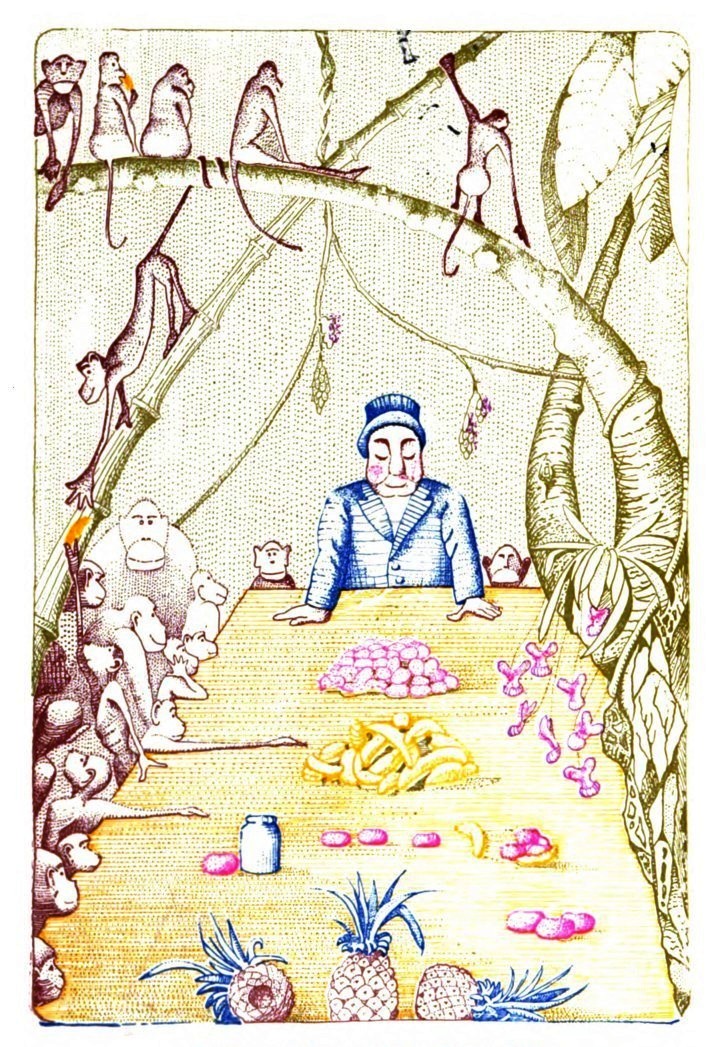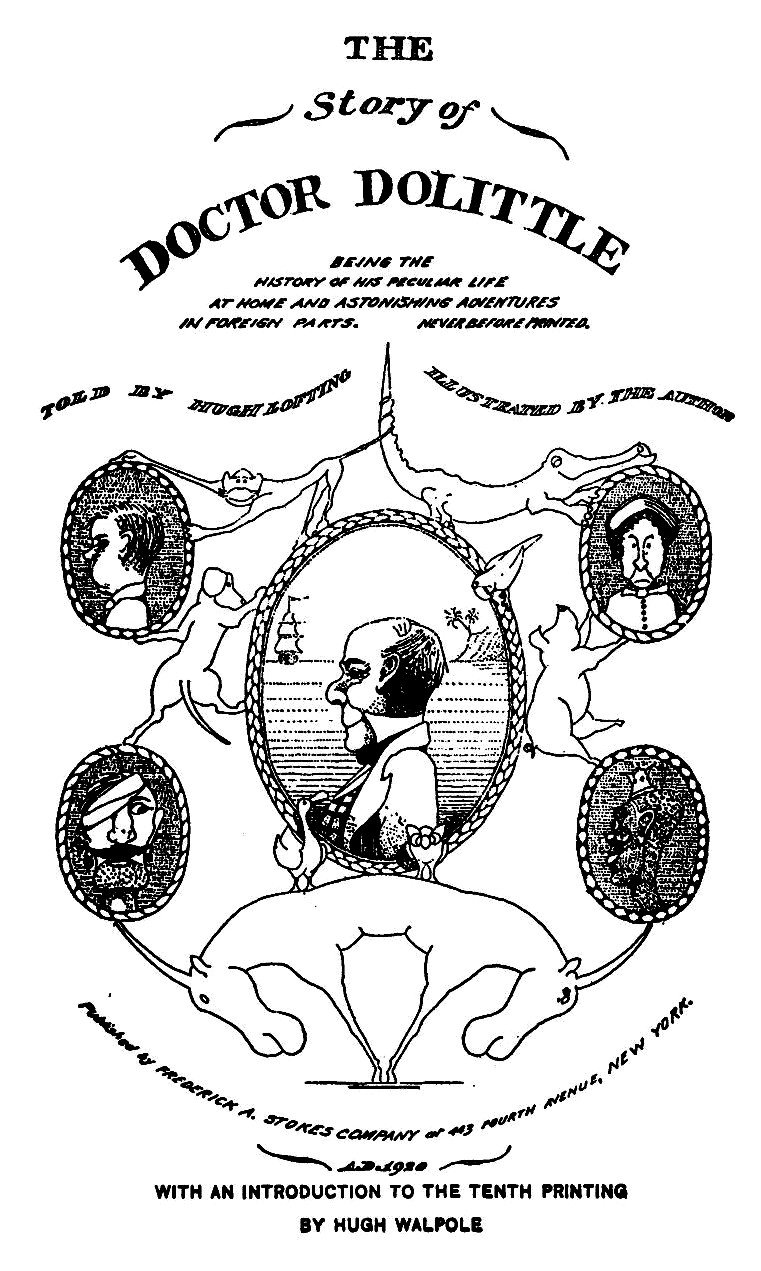 |
|
||
| Kellscraft
Studio Home Page |
Wallpaper
Images for your Computer |
Nekrassoff Informational Pages |
Web
Text-ures© Free Books on-line |
| Doctor Dolittle Being the History of His Peculiar Life at Home and Astonishing Adventures in Foreign Parts. Never Before Printed. Told by Hugh Lofting Illustrated by the Author  THE FAREWELL FEAST Published by Frederick A Stokes Company of 443 Fourth Avenue New York A.D. 1920 With an Introduction to the Tenth Edition by Hugh Walpole 
TO
ALL CHILDREN CHILDREN IN YEARS AND CHILDREN IN HEART I DEDICATE THIS STORY CONTENTS
ILLUSTRATIONS "A little town called Puddleby-on-the-Marsh" "And she never came to see him any more" "He could see as well as ever" "They came at once to his house on the edge of the town" "They used to sit in chairs on the lawn" " 'All right,' said the Doctor, 'go and get married' " "One evening when the Doctor was asleep in his chair" " 'I felt sure there was twopence left' " "And the voyage began" "At night she carried a tiny lantern" " 'We must have run into Africa' " " 'I got into it because I did not want to be drowned' " "And Queen Ermintrude was asleep" " 'Who's that?' " "Cheering and waving leaves and swinging out of the branches to greet him" "John Dolittle was the last to cross" "He made all the monkeys who were still well come and be vaccinated" " 'ME, Me King of Beasts, to wait on a lot of dirty monkeys?' " "Then the Grand Gorilla got up" " 'Lord save us!' cried the duck. 'How does it make up its mind?' " "He began reading the fairy-stories to himself" "Crying bitterly and waving till the ship was out of sight" " 'They are surely the pirates of Barbary' " " 'And you have heard that rats always leave a sinking ship?' " " 'Look here, Ben Ali — ' " " 'Sh! — Listen! — I do believe there's someone in there!' " "So he struck a match" " 'You stupid piece of warm bacon!' " " 'Doctor!' he cried. 'I've got it!' " "And she kissed the Doctor many times" "The Doctor sat in a chair in front" "He began running round the garden like a crazy thing" INTRODUCTION TO THE TENTH PRINTING Geniuses are rare and, without being at
all an undue praiser of times past, one can say without hesitation that until
the appearance of Hugh Lofting, the successor of Miss Yonge, Mrs. Ewing, Mrs.
Gatty and Lewis Carroll had not appeared. I remember the delight with which
some six months ago I picked up the first "Do-little" book in the
Hampshire bookshop at Smith College in Northampton. One of Mr. Lofting's
pictures was quite enough for me. The picture that I lighted upon when I first
opened the book was the one of the monkeys making a chain with their arms
across the gulf. Then I looked further and discovered Bumpo reading fairy
stories to himself. And then looked again and there was a picture of John
Dolittle's house. But pictures are not enough although
most authors draw so badly that if one of them happens to have the genius for
line that Mr. Lofting shows there must be, one feels, something in his writing
as well. There is. You cannot read the first paragraph of the book, which
begins in the right way "Once upon a time" without knowing that Mr.
Lofting believes in his story quite as much as he expects you to. That is the
first essential for a story teller. Then you discover as you read on that he
has the right eye for the right detail. What child-inquiring mind could resist
this intriguing sentence to be found on the second page of the book: "Besides the gold-fish in the pond
at the bottom of his garden, he had rabbits in the pantry, white mice in his
piano, a squirrel in the linen closet and a hedgehog in the cellar." And then when you read a little further
you will discover that the Doctor is not merely a peg on whom to hang exciting
and various adventures but that he is himself a man of original and lively
character. He is a very kindly, generous man, and anyone who has ever written
stories will know that it is much more difficult to make kindly, generous
characters interesting than unkindly and mean ones. But Dolittle is interesting.
It is not only that he is quaint but that he is wise and knows what he is
about. The reader, however young, who meets him gets very soon a sense that if
he were in trouble, not necessarily medical, he would go to Dolittle and ask
his advice about it. Dolittle seems to extend his hand from the page and grasp
that of his reader, and I can see him going down the centuries a kind of Pied
Piper with thousands of children at his heels. But not only is he a darling
and alive and credible but his creator has also managed to invest everybody
else in the book with the same kind of life. Now this business of giving life to
animals, making them talk and behave like human beings, is an extremely
difficult one. Lewis Carroll absolutely conquered the difficulties, but I am
not sure that anyone after him until Hugh Lofting has really managed the trick;
even in such a masterpiece as "The Wind in the Willows" we are not
quite convinced. John Dolittle's friends are convincing because their creator
never forces them to desert their own characteristics. Polynesia, for
instance, is natural from first to last. She really does care about the Doctor
but she cares as a bird would care, having always some place to which she is
going when her business with her friends is over. And when Mr. Lofting invents
fantastic animals he gives them a kind of credible possibility which is
extraordinarily convincing. It will be impossible for anyone who has read this
book not to believe in the existence of the pushmi-pullyu, who would be
credible enough even were there no drawing of it, but the picture on page 153
settles the matter of his truth once and for all. In fact this book is a work of genius
and, as always with works of genius, it is difficult to analyze the elements
that have gone to make it. There is poetry here and fantasy and humor, a little
pathos but, above all, a number of creations in whose existence everybody must
believe whether they be children of four or old men of ninety or prosperous
bankers of forty-five. I don't know how Mr. Lofting has done it; I don't
suppose that he knows himself. There it is — the first real children's classic
since "Alice." HUGH WALPOLE.
|